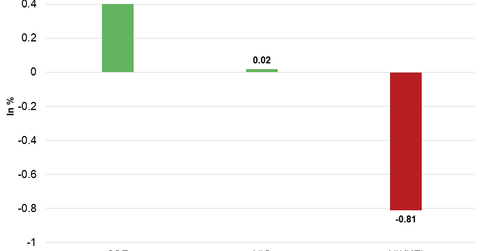Why Are Asian Markets Mixed on January 24?
The Shanghai Composite Index rose 0.4% and closed the day at 3,560.73 on January 24. The SPDR S&P China (GXC) rose 1.3% on January 23.
Jan. 24 2018, Published 8:10 a.m. ET

Economic calendar
9:45 AM EST – US manufacturing PMI (purchasing managers’ index) (January)
9:45 AM EST – US Markit composite PMI
9:45 AM EST – US services PMI (January)
10:00 AM EST – US existing home sales (December)
10:30 AM EST – US crude oil inventories
China
China’s Shanghai Composite Index gained for five consecutive trading weeks and closed last week at two-year high price levels. With improved sentiment, the Shanghai Composite Index started this week on a stronger note and gained in the first three trading days of the week.
On Wednesday, the Shanghai Composite Index opened the day higher and surged to fresh two-year high price levels. The release of stronger-than-expected GDP data and the end of the US government shutdown improved the market’s risk appetite. The health care and financials sectors pushed the market higher on Wednesday. On the other hand, weakness in the consumer staples and real estate sectors limited the market gains.
The Shanghai Composite Index rose 0.4% and closed the day at 3,560.73 on January 24. The SPDR S&P China (GXC) rose 1.3% on January 23.
Hong Kong
Hong Kong’s Hang Seng Index gained for six consecutive trading weeks and closed last week at record high price levels. The improved outlook on upcoming corporate earnings along with optimism about economic growth supported the Hang Seng Index this week. On Wednesday, the Hang Seng Index opened the day lower but closed almost flat amid profit-booking at elevated levels.
On January 24, the Hang Seng Index rose 0.02% and closed the day at 32,936.50. The iShares MSCI Hong Kong (EWH) rose 0.19% on January 23.
Japan
After trading in a range last week, Japan’s Nikkei Index started this week on a mixed note and surged to fresh 26-year price levels. On Wednesday, the Nikkei Index opened lower and traded with weakness due to the stronger yen. The release of weaker-than-expected exports and trade balance data released at after market hours on Tuesday made the market open lower on Wednesday. Weakness in the transport, construction, and chemical, petroleum, and plastic sectors weighed on the market.
On January 24, the Nikkei Index fell 0.81% and closed the day at 23,929.00. The iShares MSCI Japan (EWJ) gained 0.61% on January 23.
In the next part, we’ll discuss how European markets performed in the early hours on January 24.
